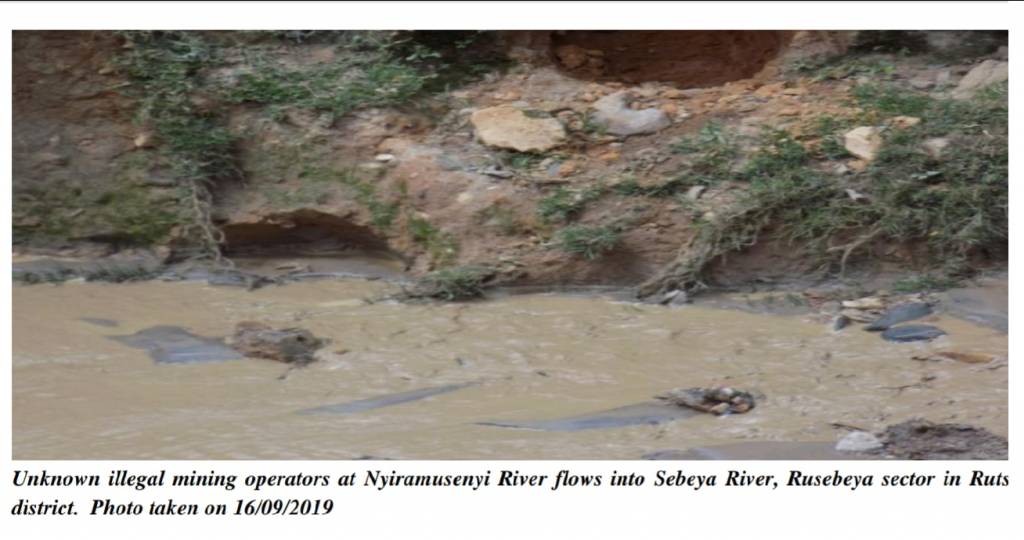There is a standard for drinking water in Rwanda recommended by the Rwanda Bureau of Standards (RSB). However, chemicals being pumped into Rwanda’s single biggest river, Nyabarongo, may be slowly poisoning tens of thousands of people along its route.
Stretching 297 kilometers, Nyabarongo River has a signature identity; dark-brown water. It flows from its source in western Rwanda southwards to its out-let, to Lake Rweru in south-eastern Rwanda along the border with Burundi. It has dozens of small streams feeding it.
Along its route, the river covers and receives water flow from several districts including Rutsiro, Rulindo, Muhanga, Ngororero, Kamonyi and on to Bugesera. Its biggest catchment area is in Kigali.
New findings by the Auditor General show that loosely regulated mining firms are pouring chemicals into the river. As a result, the river’s water has a very high concentration of poisonous chemicals such as Lead and Zinc.
As of September 2019, there is a government agency in charge of the mining sector called Rwanda Mines, Petroleum and Gas Board (RMB). In its database, maintains 97 licences for exploitation of different minerals and 79 licences for exploration activities.
The Auditor General in latest environmental assessment of the mining industry gives grim picture. The contents are in the wider 1,739-page report into state finances for 2018-2019. The report was submitted to Parliament on May 15.
The Auditor General’s team picked 28 mining sites sampled in 7 districts (2 districts in Western Province, 2 districts in Southern Province, 1 district in Northern Province, 1 district in Eastern Province and 1 district in the City of Kigali).
The quality of Nyabarongo River was found to be deteriorating due to washing minerals, mining in rivers that feed it, dumping mineral waste left-over soil and discharging waste water into the rivers.
The Auditor General conducted the first such environmental audit in 2015. The team went back in 2019 to review what had happened ever since. Situation was in fact getting worse.
The AG found that 14 mining companies located in Muhanga, Ngororero, Kamonyi, Rulindo and Rutsiro districts were still washing minerals, mining in rivers and discharging mineral waste into Nyabarongo river.
Mining operators at 15 mines sites out of 28 mining companies had not constructed dams to capture waste water. These facilities are meant to hold water doused with chemicals in one pond. Under normal circumstances, this water is supposed to be treated to remove these dangerous chemicals before it is discharge into the environment.
Companies such as Rwanda Rudniki Company, AFRISET, AFRICOME INTERNATIONAL Ltd, SOREMI Intego, and Cyamazima Berthe, all sent mineral waste left-over soil to Nyabarongo river near Nyabarongo hydro power plant located in Mushishiro sector, Matyazo cell.
At most of the mining sites, the AG found that operators did not evaluate the level of waste water contamination before releasing it to the environment. Basically, their job was to mine and didn’t care where the waste was going.
Apart from the poisonous chemicals, mining companies are also aiding the massive loss of top soil which is channeled into Nyabarongo River. It is part of the reason Nyabarongo has a distinct brown colour.
None of the 28 sites sampled had installed the required mechanism that collect, store and install traps to protect top soil as required by the mining standards.
“The soil in these mine sites are mixture with mineral waste left-over soil and piled near the mining pits and surrounding areas,” says the AG.
One particular firm SOREMI was found to be openly still sending top soil and other mining waste in Nyabarongo River and marshland.
Another problem identified by the Auditor General is that of abandoned mining sites. The audit team found open pits (abandoned) in perimeters of mine sites of the 20 visited mining sites. The companies completed one pit, and dug up another, without restoring the old one.
With all this level of mining, how clean is Nyabarongo River water? Various studies have been done.
A 2011 joint study by four major African universities including the University of Rwanda’s Faculty of Applied Sciences, declared that Nyabarongo River was “heavily polluted”.
Other institutions on the groundbreaking study on the Nyabarongo River were Uganda’s Makerere University, University of Zimbabwe, and the University of Dar es Salaam, Tanzania.
The pollution of Nyabarongo is coming from upstream – from the many mining sites, as well as factories in Kigali.
High levels of Zinc were detected in the river after Kigali going downstream. Zinc causes a wide range of medical problems to the human body including birth defects, loss of smell and organ damage.
“The level of zinc is undetectable upstream of the Nyabugogo River and starts to increase especially after the Kabuye sugar refinery factory where the highest peak of zinc level all along the Nyabugogo River is located,” reads the study.
The acidity of Nyabarongo River, was also found to be unusually higher. This is explained by the study as caused by alkaline reagents from UTEXRWA textile factory and other factories in Kigali.
The other dangerous metal that the researchers found was Lead. Young children are particularly vulnerable to the toxic effects of lead and can suffer profound and permanent adverse health effects, particularly affecting the development of the brain and nervous system, according to the WHO. It has many other dangers.
“The source of this could be the Nyabugogo tannery which uses a lot of chemicals and a lot of car parks in the area,” write the researchers.
Mining is increasingly becoming a major part of Rwanda’s economy. According to data from RMB, Rwanda’s mineral exports generated $399 million in 2017-2018 financial year, from 7,000 tonnes.
The target is at growing minerals export revenues to $800 million by 2020 and $1.5 billion annually by 2024.
The country mines significant amounts of Coltan, wolframite, gemstones, gold, and industrial minerals.
